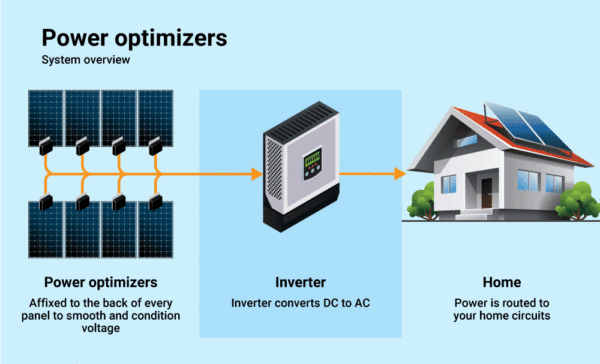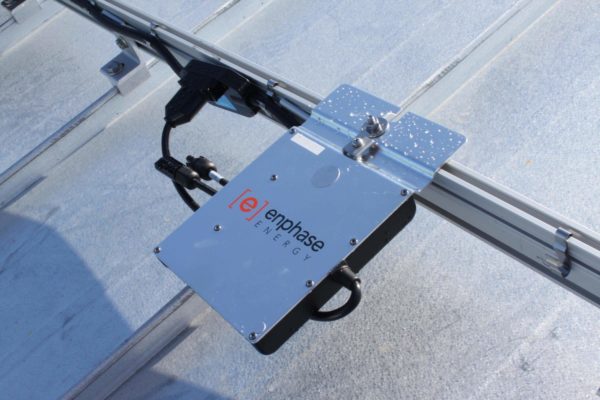In the first part of this series, pv magazine reviewed the productive lifespan of solar panels, which are quite resilient. In this part, we examine residential solar inverters in their various forms, how long they last, and how resilient they are.
The inverter, a device that converts the DC power produced by solar panels into usable AC power, can come in a few different configurations.
The two main types of inverters in residential applications are string inverters and microinverters. In some applications, string inverters are equipped with module-level power electronics (MLPE) called DC optimizers. Microinverters and DC optimizers are generally used for roofs with shading conditions or sub-optimal orientation (not south-facing).

Image: Solar Reviews
In applications where the roof has a preferable azimuth (orientation to the sun) and little no shading issues, a string inverter can be a good solution.
String inverters generally come with simplified wiring and a centralized location for easier repairs by solar technicians. Typically they are less expensive, said Solar Reviews. Inverters can typically cost 10-20% of the total solar panel installation, so choosing the right one is important.
How long do they last?
While solar panels can last 25 to 30 years or more, inverters generally have a shorter life, due to more rapidly aging components. A common source of failure in inverters is the electro-mechanical wear on the capacitor in the inverter. The electrolyte capacitors have a shorter lifetime and age faster than dry components, said Solar Harmonics.
EnergySage said that a typical centralized residential string inverter will last about 10-15 years, and thus will need to be replaced at some point during the panels’ life.
String inverters generally have standard warranties ranging from 5-10 years, many with the option to extend to 20 years. Some solar contracts include free maintenance and monitoring through the term of the contract, so it is wise to evaluate this when selecting inverters.

Microinverters have a longer life, EnergySage said they can often last 25 years, nearly as long as their panel counterparts. Roth Capital Partners said its industry contacts generally report microinverter failures at a substantially lower rate than string inverters, though the upfront cost is generally a bit higher in microinverters.
Microinverters typically have a 20 to 25-year standard warranty included. It should be noted that while microinverters have a long warranty, they are still a relatively new technology from the past ten years or so, and it remains to be seen if the equipment will fulfill its 20+ year promise.
The same goes for DC optimizers, which are typically paired with a centralized string inverter. These components are designed to last for 20-25 years and have a warranty to match that time period.
As for inverter providers, a few brands hold dominant market share. In the United States, Enphase the market leader for microinverters, while SolarEdge leads in string inverters. Tesla has been making waves in the residential string inverter space, taking up market share, though it remains to be seen how much of an impact Tesla’s market entry will make, said an industry note from Roth Capital Partners.
(Read: “U.S. solar installers list Qcells, Enphase as top brands“)
Failures
A study by kWh Analytics found that 80% of solar array failures occur at the inverter level. There are numerous causes of this.
According to Fallon Solutions, one cause is grid faults. High or low voltage due to grid fault can cause the inverter to stop working, and circuit breakers or fuses can be activated to protect the inverter from high-voltage failure.
Sometimes failure can occur at the MLPE level, where the components of power optimizers are exposed to higher temperatures on the roof. If reduced production is being experienced, it could be a fault in the MLPE.
Installation must be done properly as well. As a rule of thumb, Fallon recommended that the solar panel capacity should be up to 133% of the inverter capacity. If the panels are not properly matched to a right-size inverter, they will not perform efficiently.
Maintenance
To keep an inverter running more efficiently for a longer period, it is recommended to install the device in a cool, dry place with lots of circulating fresh air. Installers should avoid areas with direct sunlight, though specific brands of outdoor inverters are designed to withstand more sunlight than others. And, in multi-inverter installations, it is important to be sure there is proper clearance between each inverter, so that there isn’t heat transfer between inverters.

Image: Wikimedia Commons
It is a best practice to inspect the outside of the inverter (if it is accessible) quarterly, making sure there are no physical signs of damage, and all vents and cooling fins are free from dirt and dust.
It is also recommended to schedule an inspection through a licensed solar installer every five years. Inspections typically cost $200-$300, though some solar contracts have free maintenance and monitoring for 20-25 years. During the checkup, the inspector should check inside the inverter for signs of corrosion, damage, or pests.
Post time: May-13-2024